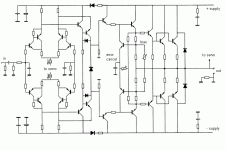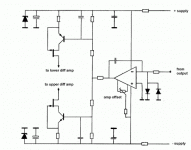I don't think it even means that insofar as many amplifiers
with zero global negative feedback have internal loops over
one or more stages.
I think the marketing term for zero-feedback allows for
degeneration only. Zero global negative feedback means
that there is no loop over the entire amplifier.

Hi Nelson,
I agree, and I think this corresponds to Charles Hansen's definition of a no-feedback amplifier, if I am not mistaken. Degeneration only is OK. Any other local feedback, even if it does not enclose the output stage, disqualifies the amplifier as being no feedback. For example, a stage with shunt feedback would not qualify. This is a fairly strict definition of no feedback, and I'm sure many others do not abide by it.
Many would be surprized, but I have a chapter in my book on no-feedback amplifiers and also amplifiers with wide open-loop bandwidth. Part of the reason is to be fair to those with diverse design philosophies, but another part of it is that designing no-feedback amplifiers that can perform well is quite challenging. One thing I take note of and raise a question on is whether a DC servo is permitted in a no-feedback amplifier. It can make life a lot easier, but I suspect that the use of a DC servo disqualifies an amplifier from the strict interpretation as well.
Cheers,
Bob
One thing I take note of and raise a question on is whether a DC servo is permitted in a no-feedback amplifier. It can make life a lot easier, but I suspect that the use of a DC servo disqualifies an amplifier from the strict interpretation as well.
Cheers,
Bob
Complementary symmetric topology amps sometimes have the servo control the input diff-pair +/- current sources instead of summing into the diff input. I use this servo in my global negative feedback amps because I believe it gives a more dynamic sound by not summing the opamp error signal with the output feedback.
I have seen a few no_global_feedback amps use this type of servo.
Attachments
One thing I take note of and raise a question on is whether a DC servo is permitted in a no-feedback amplifier. It can make life a lot easier, but I suspect that the use of a DC servo disqualifies an amplifier from the strict interpretation as well.
I am only striving for clarity, not picky interpretations. A
DC servo is OK by me. I also don't regard cascoding as a
gain stage or differential pairs as two gain stages.
[snip]
Anyone know some good Amplifiers using positive feedback?????
Yes, I do: Bob's HEC OPS.
Haha.
What kind of amp is that?
But I guess Bob Cordell's h-error-correction outputstage
uses a bit of positive feedback to achieve result.
Edmond.
* By the way, I have been thinking maybe apply for 'the other forum'.
* I see you are active there and other guys with high level of knowledge.
What kind of amp is that?
But I guess Bob Cordell's h-error-correction outputstage
uses a bit of positive feedback to achieve result.
Edmond.
* By the way, I have been thinking maybe apply for 'the other forum'.
* I see you are active there and other guys with high level of knowledge.
another reason for being clear on what is negative feedback and when there is built in negative feedback is that positive feedback lets you get at the gain of a device or circuit block with internal negative feedback - like triodes
in the HEC example I believe it is useful to think of the positive feedback "unmasking" the gain of the driver bjt despite their running as emitter follower with local unity gain negative feedback
in the HEC example I believe it is useful to think of the positive feedback "unmasking" the gain of the driver bjt despite their running as emitter follower with local unity gain negative feedback
Last edited:
Error Correction circuit uses positive, negative or null feedback according to what is demanded by the remaining part of circuit to make the whole having a linear response.
EC works by bringing a circuit into balance, so adds to signal input (positive feedback), substracts from it (negative feedback) or does nothing at all (no feedback) to achieve this aim.
"Feedback on demand", has it not been described as this ?
EC works by bringing a circuit into balance, so adds to signal input (positive feedback), substracts from it (negative feedback) or does nothing at all (no feedback) to achieve this aim.
"Feedback on demand", has it not been described as this ?
Haha.
What kind of amp is that?
But I guess Bob Cordell's h-error-correction output stage
uses a bit of positive feedback to achieve result.
 That's right.
That's right.Edmond.
* By the way, I have been thinking maybe apply for 'the other forum'.
* I see you are active there and other guys with high level of knowledge.
Well, in the past I was indeed active 'over there', but the misbehavior of one of the members has decided me to leave that place.
So I can't introduce you to that 'body of knowledge'.
Cheers,
E.
Error Correction circuit uses positive, negative or null feedback according to what is demanded by the remaining part of circuit to make the whole having a linear response.
EC works by bringing a circuit into balance, so adds to signal input (positive feedback), substracts from it (negative feedback) or does nothing at all (no feedback) to achieve this aim.
"Feedback on demand", has it not been described as this ?
HEC simply isn't that "smart" - the elaborate descriptions are due to attribution of human style heuristics to a circuit that simply uses nested positive and negative feedback in a uncommon way
Bob's Mosfet Amp HEC can be usefully analyzed as having high gain local feedback around the output stage - at audio frequencies the local loop's gain is very high and can change sign over some frequencies depending on component tolerances and circuit operating point - but not in a coordinated fashion with any "knowledge" of what’s "best" for signal/load at any time
Last edited:
I am only striving for clarity, not picky interpretations. A
DC servo is OK by me. I also don't regard cascoding as a
gain stage or differential pairs as two gain stages.

Agreed completely.
BTW, I'm also assuming that a CFP stage would disqualify an amplifier from the more strict definition of no-feedback, as it is a case of very strong local feedback.
The CFP could be tempting for some to use in a no-feedback amplifier input stage, as that stage must handle the full line level signal in a no-feedback amplifier, and a straight LTP may thus be prone to creating distortion without VERY heavy degeneration.
One alternative approach is to use a cascomp input stage. I note that one can also apply the cascomp concept to JFET input stages.
One can also use a cascomp in the VAS.
Cheers,
Bob
Sorry for the delay in responding, but I've been away for a few days.Like its inventor Harold Black and my favorite text Horowitz
and Hill, I regard negative feedback as "the process of
coupling the output back in such a way as to cancel some of
the input".
I don't see the two as the same, although some of the effects
are the same. Some aren't, for example degeneration does
not particularly alter the output impedance, nor does it suffer
the same sorts of bandwidth stability issues as loop feedback.
Degeneration does couple the output back, but it is the output current rather than the output voltage which is used. This means that it raises the output impedance just as effectively as voltage sensing feedback lowers it. The stability issues are less of course simply because there is less scope for multiple roll-offs in a single stage. However, a single emitter follower can become unstable with a capacitive load so even degeneration is not guaranteed to be stable.
In my view there is almost no such thing as a low distortion zero feedback amp. Degeneration is a form of feedback, and so are triodes! A long-tail pair used with sufficiently small signals is one possible candidate for near enough zero feedback, but some might even dispute that.
I just found this thread :
http://www.diyaudio.com/forums/solid-state/12752-blind-listening-tests-amplifiers.html
which also talks about the Richard Clark challenge and how nobody passed it yet.
If it's true that in blind tests people cannot distinguish between two "good enough" amplifiers then maybe all this quest for the "perfect amplifier" is futile.
Then all "good enough" amplifiers sound the same, any further improvements in THD, IM, etc. cannot be heard but only measured, there is no difference between the sounds of tube, transistors, chips, etc..
What do you think about that ?
P.S.: I'm starting to want to do my own blind test - I'll be the first lab rat since I'm also very gullible and agree to any scientific test where I am the subject
http://www.diyaudio.com/forums/solid-state/12752-blind-listening-tests-amplifiers.html
which also talks about the Richard Clark challenge and how nobody passed it yet.
If it's true that in blind tests people cannot distinguish between two "good enough" amplifiers then maybe all this quest for the "perfect amplifier" is futile.
Then all "good enough" amplifiers sound the same, any further improvements in THD, IM, etc. cannot be heard but only measured, there is no difference between the sounds of tube, transistors, chips, etc..
What do you think about that ?
P.S.: I'm starting to want to do my own blind test - I'll be the first lab rat since I'm also very gullible and agree to any scientific test where I am the subject
One alternative approach is to use a cascomp input stage. I note that one can also apply the cascomp concept to JFET input stages.
I probably know the circuit, but I don't know the term.
What is it?
I probably know the circuit, but I don't know the term.
What is it?

The cascomp was invented by Pat Quinn at Tektronix to provide for wideband vertical oscilloscope amplifiers with low distortion without the use of NFB.
The idea is elegant and simple. Envision a BJT loaded by a cascode. Recognize that the LTP distortion arizes from the nonlinear voltage across the LTP BJT intrinsic resistance re' that varies current. Further recognize that a replica of the same nonlinear re' voltage exists emitter-to-emitter of the cascodes. We can harvest that error signal. Take another identically-degenerated LTP and feed it from the emitters of the cascodes. Take the outputs of the added error-harvesting cascode and connect them in opposite polarity to the collectors of the cascodes to cancel the error current from the original main LTP. This is thus a form of feedforward error correction. Put another cascode on top, if desired, so that the collectors of the error LTP are also cascoded.
Although I have not seen it done by others, I have applied the cascomp technique to JFET input stages. Although the operating characteristics of JFETs are different than BJTs, the same error cancelling principles apply. The main LTP, the cascodes, and the error LTP are all mase up of JFETS, three matched pairs. Matching among the pairs is desirable, but not critical, and like pairs are easily found in the same batch of devices. Distortion is reduced by a factor of 5 or more. I show a set of curves of performance of the JFET cascomp in a chapter of my book.
Cheers,
Bob
- Home
- Amplifiers
- Solid State
- Negative feedback and distortion

